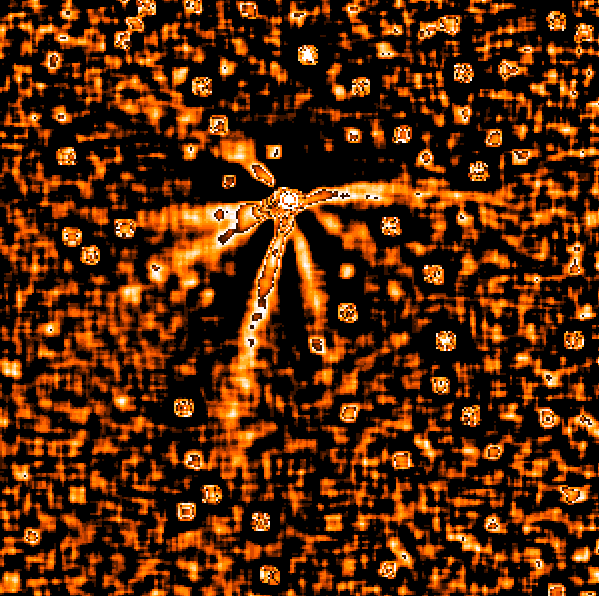
home •
about •
essential guide •
picture of the day •
thunderblogs •
news •
multimedia •
predictions •
products •
get involved •
contact
picture of the day archive subject index
Credit: N. Thomas (MPAE) et al., 1.5-m La Silla Telescope, ESO
Dec 29, 2006
The Jets of Hale-BoppWhen the comet Hale-Bopp began discharging beyond the orbit of Jupiter, it marked the beginning of the end for standard comet theory.
One of the observations leading to the dirty snowball theory of comets was that most of the periodic comets begin to grow tails at about the same distance from the Sun: between Jupiter and Mars. The determining factor was thought to be the distance at which the comet became hot enough for water and other volatile substances to evaporate into space, creating the coma, or "head," and tail of the comet.
But not every comet obeys even this tenuous "dirty snowball" criterion. Hale-Bopp in particular broke many of the rules. In the photo seen here, it is still too far from the sun for a "snowball" to melt, but it already displays seven jets.
Four years after Hale-Bopp left the inner solar system, it was still active. It displayed a coma, a fan-shaped dust tail, and an ion tail -- even though it was farther from the Sun than Jupiter, Saturn or even Uranus. The comet's tail was shrinking, but it was still about five times longer than the distance between the Earth and the Moon. At this distance, the Sun's heat will not melt ice. If it could, the icy moons of Saturn and Jupiter would be as dry as our own scorched Moon.
From an Electric Universe point of view, a comet's tail arises from the INTERACTION between the electric charge of the comet and the solar discharge plasma. The comet spends most of its time far from the Sun, where the plasma charge density is low. The comet moves slowly and its charge easily comes into balance with that region. On the other hand, as the comet approaches the Sun, the nucleus moves at a furious speed through regions of increasing charge density and varying electrical characteristics. The comet's surface charge and internal polarization, developed in deep space, responds to the new environment by forming cathode jets and a visible plasma sheath, or coma. The jets flare up and move over the nucleus irregularly, and the comet may shed and grow anew several tails. Or the comet may explode like an overstressed capacitor, breaking into separate fragments or simply giving up the ghost and disappearing.
The dirty snowball model was never tenable and has been discredited. This has profound implications for theories of the origin of the solar system.
___________________________________________________________________________Please visit our Forum
The Electric Sky and The Electric Universe available now!

|
|

|
EXECUTIVE EDITORS:
David Talbott, Wallace Thornhill
MANAGING EDITORS:
Steve Smith, Mel Acheson
CONTRIBUTING EDITORS: Dwardu Cardona, Ev Cochrane,
C.J. Ransom, Don Scott, Rens van der Sluijs, Ian Tresman
WEBMASTER: Brian Talbott
Copyright 2006: thunderbolts.info
![]()
home •
thunderblogs •
forum •
picture of the day •
resources •
team •
updates •
contact us

